Hi Donia. Indeed, they are kind of wonderfully strange. You are looking at a set of rare natural saltwater pearls from bivalves that live in ocean waters near the Philippines. As GIA researchers have shared, non-nacreous pearls like these consist chemically mainly of layers of fibrous aragonite as processed by the bivalve mollusks that create them. They are hardly ever perfectly spherical but instead form these wonderful irregular shapes such as button or baroque, and are extremely rare. These have an attractive and strong porcelaneous surface, and are a creamy white color that looks like it is over a pinkish and yellow under color that makes them quite energetically interesting. They will eventually make a spectacular necklace, once strung together.



